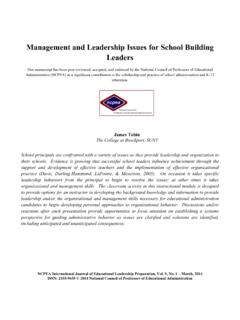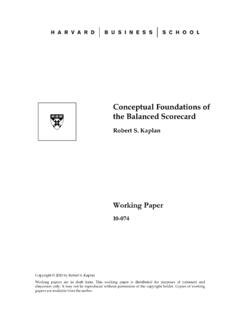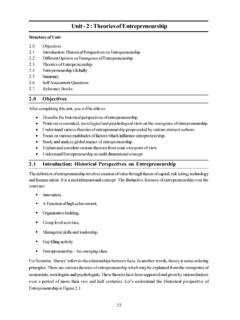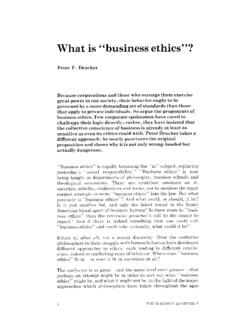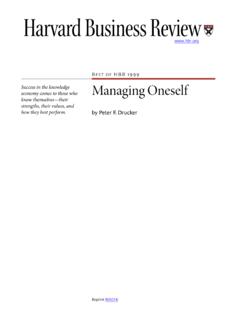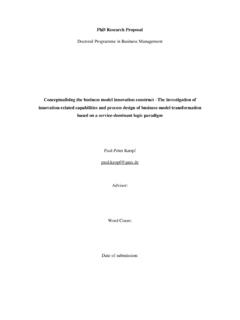Transcription of Discovering Purpose: Developing Mission, Vision & Values
1 Copyright 2005. Strategic Thinking Institute. All rights reserved. Discovering Purpose: Developing Mission, Vision & Values By: Rich Horwath That business purpose and business mission are so rarely given adequate thought is perhaps the most important cause of business frustration and failure. peter drucker Why did you attend that meeting this morning? Why have you chosen to pursue customer segment X and not customer segment Z? Hopefully, the answers support your business purpose, either current or future. Understanding why is perhaps the most motivating and success-driving reason for realizing your full potential. As a French researcher once noted, Those who know why they are fighting will win over those who don t.
2 Purpose comes in two forms: current purpose, or mission; and future purpose, or Vision . A mission is a clear, concise and enduring statement of the reasons for an organization s existence today. A Vision represents future purpose, providing a mental picture of the aspirational existence that an organization is working toward. Supporting both the current and future purpose are Values . Values are the ideals and principles which guide the thoughts and actions of an organization and define its character. Working together, mission, Vision and Values provide a powerful directional force for unifying and coordinating actions and decisions to ensure the optimal use of resources. As strategy is concerned with the intelligent allocation of limited resources, we can see that identifying a current and future purpose is critical.
3 From a strategic thinking perspective, establishing a clear and compelling purpose provides the general basis or criteria on which resource allocation decisions should be made and measured against. Without purpose, the rationale for decision making becomes subjective and disconnected from the goals and objectives trying to be achieved. We often hear the term seeing the big picture in reference to having a strategic, rather than a tactical, perspective. This phrase is rooted in your ability to understand the greater purpose for why the organization and specifically you, perform the work that you do. Understanding the current (mission) and future ( Vision ) purpose moves you from a one-dimensional rationale to the 30,000 foot view. And at 30,000 feet, you can t help but see the big picture.
4 Current Purpose: Mission Statement A mission is the current reason for being. Why is this organization in business? What is the marketing group s purpose? How do I contribute to the overall cause? Although a seemingly simple proposition, creating an effective mission statement can be one of the most challenging aspects of strategic thinking because it forces you to examine the very Copyright 2005. Strategic Thinking Institute. All rights reserved. 2 core of why. It s also one of the most overlooked parts of strategy development, as everyone assumes they are working toward the same purpose. However, the perils of this assumption cannot be underestimated. As human beings, we are driven to a great extent by our emotions. In order to take advantage of the power of the organization s emotional energy, a rationale born from this emotion is necessary to complement the financial and business reasons for work.
5 While the paycheck is important, it only provides one side of the why-we re-here coin. Creating a sound current purpose addresses the other side of the coin. To generate the greatest creativity and extricate the deepest level of talent from an organization, don t tell them what to do and how to do it tell them who they are. Defining the mission, Vision and Values accomplishes that task. The mission statement also serves to begin to frame the business strategy. As the scope of business, customer targets and competitive arena are addressed in the mission statement, it naturally serves to begin defining elements of the business strategy. Defining these elements also forces you to decide what not to do, one of the key characteristics of strategic thinking. It is in this process of choosing what not to do and who not to target as customers that the business focus emerges.
6 The importance of focus was clearly articulated by the noted military historian Hart when he said: The principles of war can be condensed into one word concentration. One element of the mission that is often overlooked is the importance of the belief and commitment to it once it s developed. As with the United States Constitution and the Bible, a mission statement is only effective for those who believe in it. The belief then must go hand-in-hand with the commitment to follow it. A New Year s resolution statement is worthless in and of itself. It is the commitment to the New Year s resolution that matters, as evidenced by all the resolutions that have gone by the wayside. Once the organization s mission is in place, mission statements for departments and functional groups within the organization are appropriate.
7 Mission statements at these levels tend to be more specific and more closely reflect the daily activities of the particular group. Developing these sub-mission statements also acts to further clarify the why at that level and create greater team unity both of which make for a stronger overall organization. Sub-missions are often overlooked, but can become a powerful motivator and guide for specific functional groups or departments. Benefits of a Mission Statement The mission statement, or current purpose, is first and foremost one of the five key elements of strategic thinking. Without a current purpose, the crucial function of decision making has no objective basis from which to be measured. The mission statement gives everyone a baseline that guides and unifies decision making.
8 Secondly, the mission statement ensures that different functional groups within the organization or individuals within a department have the same underlying rationale for actions. In this sense, the purpose unifies efforts and maximizes the utilization of Copyright 2005. Strategic Thinking Institute. All rights reserved. 3 resources to reach the established goals and objectives. Acting as a compass, it ensures that everyone is pulling in the same direction. Third, it addresses the deeper, emotional component of why people do what they do for an organization or customer base. It taps into the right-brain (emotional, intuitive, visual, and synthesizing) versus the left-brain (logical, reasoning, quantitative, analyzing). As we discussed before, the left-brain is satisfied by the paycheck; the right-brain needs something more, something that appeals to the emotional side.
9 The mission statement acts to fulfill the emotional needs of the right-brain, creating a satisfied whole. Fourth, companies with mission statements have a higher likelihood of financial success. Research has shown that companies with a well-crafted mission statement have greater financial success and are recognized for superior quality compared to companies with poor or nonexistent mission statements. Other studies have reported firms working by a mission statement have a 30% higher return on certain financial measures than firms that lack mission statements. Not only does identifying and articulating a mission statement make common sense, it also makes financial sense. Finally, the current purpose or mission statement acts as a rallying point for people in good times and in bad times.
10 A mission statement focuses people on the truly important things that will drive success. In difficult times, the mission statement serves as a reminder to stay on the task at hand. It also helps prevent people from becoming reactive to minor competitor moves, and instead helps them follow the course that has been set. Criteria for a Mission Statement In addition to being a clear and concise statement that represents the reason for being, a good mission statement should answer the following four questions: 1. What function is performed? 2. How is the function performed? 3. For whom is the function performed? 4. Why is the function performed? What function is performed? The first question to be answered is, What do you do? On the surface, this may seem to be a ridiculously obvious question and answer.





